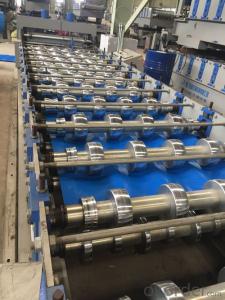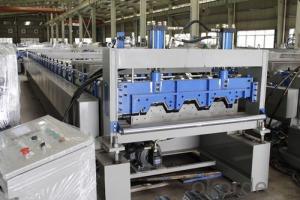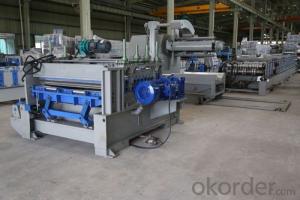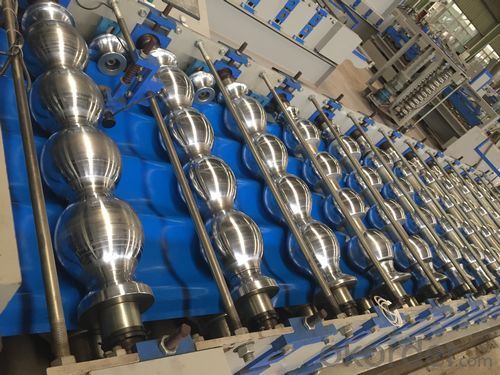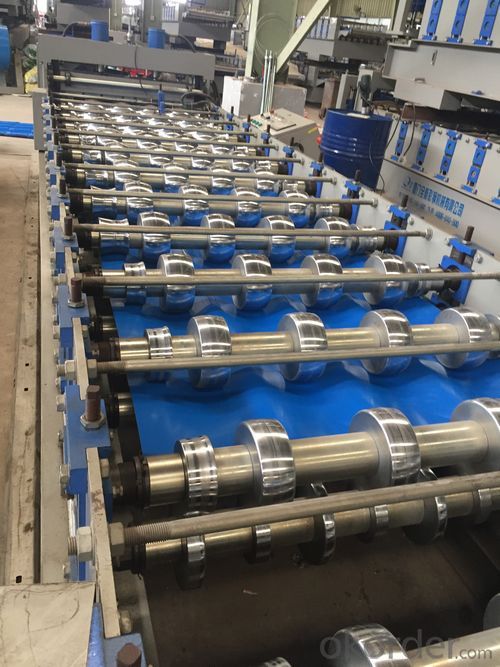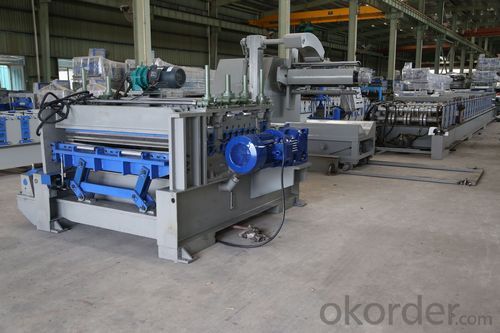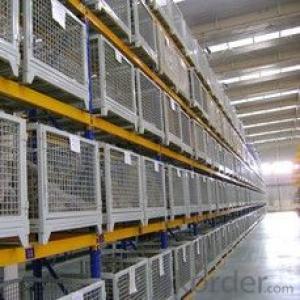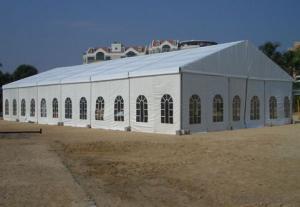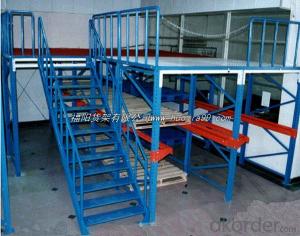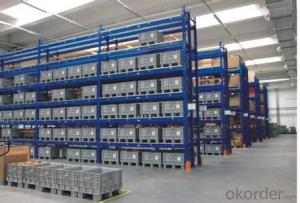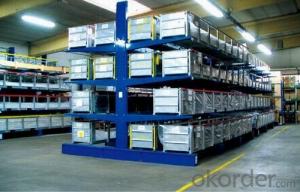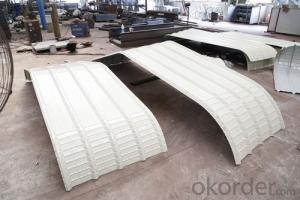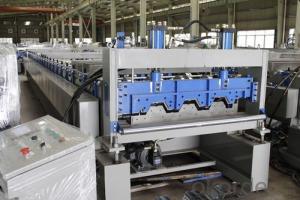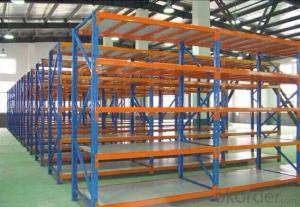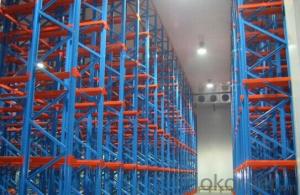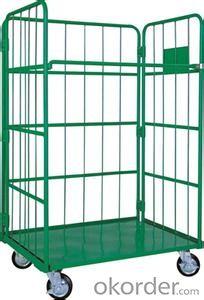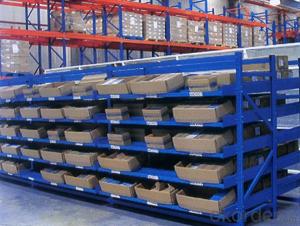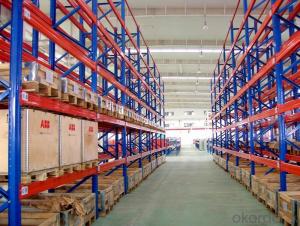trapezoidal corrugated Roof Panel Forming Machine 1000mm
- Loading Port:
- Shanghai
- Payment Terms:
- TT OR LC
- Min Order Qty:
- 1 pc
- Supply Capability:
- 300000000 pc/month
OKorder Service Pledge
OKorder Financial Service
You Might Also Like
Main Components
1.Manual Decoiler: one set
Un-powered,Manually control steel coil inner bore shrinkage and stop,
Max Feeding width: 1250mm,coil ID range 508mm±30mm
Capacity: Max. 5 Ton
2. Main machine
With feeding material guide, body frame made from H350 type steel by welding;
Rollers manufactured from 45# steel,CNC lathes,Heat Treatment, hard Chrome Coated;
Shafts Diameter=ф75mm,precision machined
Gear/Sprocket driving, about 18-step to form
Main Motor=5.5KW , Frequency speed control
Forming speed approx.13-15m/min
3. Hydraulic Cutting device:
Cutter frame made from high quality 20mm steel plate by welding
Post cut, stop to cutting,Two pieces cutting blades,no blanking
Hydraulic motor: 2.2KW Cutting pressure: 0-12Mpa
Cutting tool material: Cr12, Heat treatment
4. PLC Control System
Control the quantity and cutting length automatically
Combined with: PLC, Inverter, Touch Screen, Encoder, etc
PLC: Delta brand (Taiwan)
Inverter: Delta brand (Taiwan)
Touch Screen: WEINVIEW brand (Taiwan)
Encoder: KOYO brand (Japan)
Cut-to-length tolerance≤±2 mm
5. User's manual in English
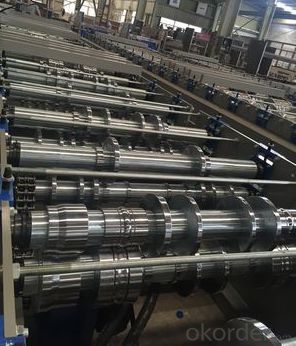
- Q: What are the basic principles of warehousing?
- The "warehouse" also known as the warehouse, store items for buildings and facilities, for housing construction, large containers, caves or specific sites, is to store and protect the function of items; "reservoir" said storage for use, storage, storage, delivery and use of means, when applied to tangible items also for storage. "Warehousing" is the act of using a warehouse to store and store items that are not immediately available. In short, warehousing is the act of storing goods in a particular place.
- Q: What are the key functions of warehouse management logistics informatization construction?
- WMS and automatic identification technology are inseparable, with large technology, a dozen focus on enterprise warehouse management research and development, the success of many large domestic enterprises to solve the problem of warehouse management.According to the existing customer database system for analysis, for each product to establish a bar code identification, bar code bar code printer to print the barcode label, resulting in the sequence number, the relevant information should be included in each of the barcode products. (customized by the customer) can include the product name, specifications, quantity, bar code serial number, date of warehousing and date of delivery. ---- initial information collection, EBIG logistics and warehousing management system (WMS)
- Q: How to strengthen the integration and construction of logistics infrastructure
- Specialized facilities. Refers to a specific area, because of its downstream business relations and production related enterprises are relatively concentrated, or as the regional freight is more concentrated in the node area, need to provide specialized facilities on the requirements of logistics management, including logistics park, logistics center and distribution center, so that in a specific area to achieve supply chain centralized management the function of.
- Q: How to carry out logistics warehousing operations?
- The central command center can be a project management organization that guides the completion of inventory, new accounts, reports, results of implementation, and progress in each department, while maintaining external customer contacts. The command center should consist of two parts: people and systems.Warehouse management system can implement including import goods management, inventory management, order management, sorting, check, goods and goods, basic information management, replenishment strategy, library mobile combination "wall" system function, but also consider the warehouse management system and transportation management system, interface between customer management, staff management system.The role of man in the command center cannot be replaced by technology. Logistics project managers need to allocate the limited resources on the basis of a large amount of data. Warehousing is not an automated business. There are too many uncertainties in warehousing. It is necessary to take charge of the familiar person inside and outside the warehouse.
- Q: What are the storage facilities and equipment included?
- The warehousing industry of our country will develop in a harmonious atmosphere of the simultaneous growth of construction and demand, and the network, information and advanced information technology will become an effective way to develop it.
- Q: What are the common logistics equipment?
- According to the special functions of the equipment, it can be divided into transportation equipment, storage and storage equipment, loading and unloading equipment, circulation processing equipment, packaging equipment, information processing equipment, etc..
- Q: What are the commonly used facilities in the logistics industry?
- Unloading machinery and equipment (loading and unloading machines are common: bridge cranes, Longmen cranes, gantry cranes, and some mobile cranes. Transportation: belt conveyor, bucket elevator, screw conveyor, rod conveyor, pneumatic conveyor and so on
- Q: What is the warehousing logistics distribution center?
- The distribution center must first purchase the goods to be supplied and distributed in order to supply materials to its users, that is, manufacturing enterprises or commercial enterprises, in a timely and accurate manner. The distribution center shall formulate and adjust the unified and comprehensive purchasing plan according to the change of supply and demand in the market, and shall be organized and implemented by special personnel and departments.
- Q: What are the main facilities and equipment in the warehouse?
- 1, a variety of specialized warehouses;2. Facilities in the warehouse;3, all kinds of ancillary equipment, such as: explosion protection, fire fighting, metering, temperature measurement, ventilation, information management, etc.
- Q: What are logistics facilities and equipment?
- Logistics facilities and equipment are the material and technical basis for organizing and conducting logistics activities.
Send your message to us
trapezoidal corrugated Roof Panel Forming Machine 1000mm
- Loading Port:
- Shanghai
- Payment Terms:
- TT OR LC
- Min Order Qty:
- 1 pc
- Supply Capability:
- 300000000 pc/month
OKorder Service Pledge
OKorder Financial Service
Similar products
Hot products
Hot Searches
Related keywords

